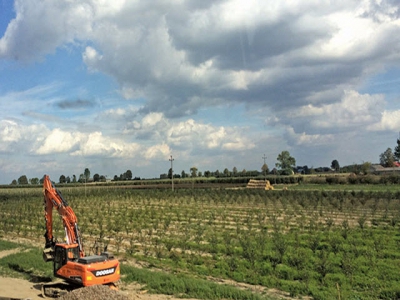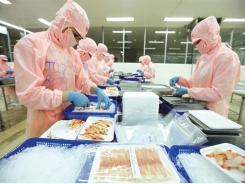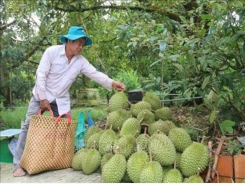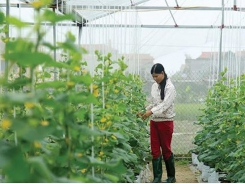Farming in Poland, Europes growth engine

Poland is a country grounded in agriculture and forestry. Although the sector contributes only 3,5% to the country’s economy, more than 60% of Poland’s total land area is taken up by farming, and 12% of the country’s workforce is employed in the agricultural sector.
The primary agricultural sector makes up only 3,5% of the country’s economy, but more than 60% of Poland’s total land area is taken up by farming. Photo: Denene Erasmus
According to statistics, there are roughly 1,5 million small family farms of less than 9ha in Poland. The country’s Agricultural Market Agency (ARR) reports that these farms are struggling to remain competitive, and there has been a move to consolidate smaller farms into larger units in recent years.
The country’s Agricultural Market Agency (ARR) reports that these farms are struggling to remain competitive, and there has been a move to consolidate smaller farms into larger units in recent years.
ARR president Łukasz Hołubowski says that one of the main drivers of agricultural development has been an increase in average farm size from 5ha to about 9ha.
“There has also been a strong emergence of cooperative-type farming as farmers join forces to strengthen their collective bargaining power, and cooperative-type farming as farmers join forces to strengthen their collective bargaining power, and government has also been very supportive of agriculture. It’s one of the fastest- developing sectors in the country and that’s why we’re placing a lot of emphasis on developing new markets,” he explains.
At the same time, since joining the EU in 2004, the government has attempted to preserve farming traditions by assisting small family farms to diversify and specialise in order to maintain a competitive edge.
As a result of the EU and the government’s support, the Polish farming sector has become one of Europe’s most innovative, and boasts a higher number of young farmers than any other EU country.
Approximately 14,7% of the country’s farmers are younger than 35, compared with only 7,5% across all EU countries. Only 8,4% of Polish farmers are older than 64, compared with 30% across the EU.
Adding value
In the early 1990s, small-scale farmers struggled to earn a proper living, and many took jobs in other sectors, while farming just for their own needs. But after 2004, a cash influx and demand from the EU saw farm incomes triple over the next decade.
Accession to the EU gave farmers access to funds from the Common Agricultural Policy (CAP), and in particular, to direct payments for all farms of one hectare or more.
Along with EU cash, farmers also benefited from increased domestic spending on agriculture. Appropriations from the Polish state have nearly tripled since joining the EU.
All this has sparked growth and transformation in agriculture. Between 2014 and 2015, the value of agricultural exports increased 7,7% to €23,6 billion (R354 billion), while imports rose 4,7% to €15,9 billion (R238,5 billion), resulting in a healthy, positive trade balance of €7,7 billion (R115,5 billion), according to ARR.
Dariusz Goszczyński, deputy director of agricultural markets at the Polish Ministry of Agriculture and Rural Development: Geographic Indicators, says that greater access to the EU market has been key to sustaining small family farms.
“Because agricultural promotion in the EU is very much aimed at increasing appreciation for, and consumption of, high-quality, traditional, regional produce, even smaller-scale farmers are able to compete by offering quality instead of quantity. In the EU, consumers look for products that adhere to a wider set of quality standards than just food safety.
FARMING IN POLAND
- The primary agricultural sector accounts for 3,5% of the country’s economy (total GVA).
- Poland has about 1,4 million farms that are smaller than 10ha.
- This represents about 70% of private agricultural holdings in Poland.
- About 60% of the population of 38 million is urbanised.
- About 12% of the population is employed in the agriculture sector.
- 14,7% of farmers are younger than 35 years.
- Agricultural exports amount to €23,6 billion/year (R354 billion/year).
Sources: FAO, ARR and European Commission
They look for products with more intrinsic value, such as the origin of the product, for example, products such as Parmigiano-Reggiano, or Parmesan cheese, produced in specific regions in Italy,” he says.
Goszczyński explains that these products are awarded one of three European Quality Marks: Protected Designation of Origin (PDO), Protected Geographical Indication (PGI), or Traditional Speciality Guaranteed (TSG), a European mark awarded to regional and traditional products of exceptional quality.
Nine Polish products have been awarded the PDO mark thus far, 19 have been awarded the PGI mark, and nine have been awarded the TSG mark.
“Smaller family farms that produce excellent produce, but find it hard to compete commercially, can use these European Quality Marks to differentiate their produce and charge higher prices that will help them become financially stable.”
Growth of organic farming
“Because of their size and the fact that they usually follow a more traditional, less intensive approach, they can also easily convert to organic farming. This allows them to compete on the basis of quality rather than strictly on price with large, commercial producers,” says Goszczyński.
Impressive growth has been experienced in the organic farming sector and Poland now has about 25 000 organic farms and 500 companies that process organic produce, he says.
Since 2007, CAP has invested more than €25 billion (R373 billion) in Poland’s farming sector and rural areas, with the objective of stabilising farmers’ income, modernising and increasing the sustainability of farms, and securing the supply of safe, affordable and quality food for its citizens, according to the European Commission.
Polish farmers benefit by receiving direct payments from CAP, and in recent years these direct payments have been a key safety net, particularly for small family farms.
The exports of agricultural products from Poland to other EU countries in the past 10 years have multiplied fivefold and Poland has continued to be a net exporter of agricultural products.
Export market
The EU remains by far the most important market for Polish agricultural products, accounting for 80% of all exports. The country produces a range of agricultural products (see Table 1), but the products that contributed most to total export sales in 2015 were poultry, chocolate, beef, wheat, pork, dairy and fruit juice.
Among CAP’s goals for 2014 to 2020 is supporting small and family-owned farms, and Poland has been identified as one of the primary beneficiaries, according to the European Commission. During this period, CAP will invest more than €32 billion (R480 billion) in the country’s farming sector and rural areas.
Europe’s growth engine
According to a report by McKinsey & Company, ‘Poland 2025: Europe’s new growth engine’, Poland offers more advantages than any other country in terms of becoming Europe’s major food production and processing hub.
The report states that growing urbanisation across Europe is raising Poland’s profile as a major food supplier. Poland ranks fourth in the EU in terms of arable land after France, Germany, and Spain, and 200 million EU citizens live within 1 000km of Poland’s borders.
But while the sector has gone through radical changes over the past 25 years, a large productivity gap of about 59% remains between Poland the rest of the EU.
“Low productivity is primarily driven by fragmented holdings. The average farm size in Poland is approximately 10ha, compared with 50ha in France and Germany, and 90ha in the UK.
Fragmentation is a problem when it comes to animal production as well. In 2010, the average swine herd in Poland [consisted of] 39 animals, while in Germany the number was 450 and in Denmark, 2 600,” the report said.
Poland’s agriculture and food industry is also skewed toward low value-added produce. But, the report states, the country has been moving in the right direction, with value-added food production growing faster than total volume.
“As a result of investment, the Polish food-processing industry enjoys very modern production- line infrastructure, especially for dairy, meat, frozen food and beverages. Facilities are often more advanced than those of EU peers.”
However, despite favourable natural conditions and fast-growing investments, Poland is not yet “a food-processing champion”.
To fully achieve its growth potential, Polish agriculture would have to assist companies to increase investment in brand creation, and address the fragmented sectoral structure by encouraging consolidation of smaller farming units into larger business entities of a large enough scale to satisfy international demand.
Promoting branded produce
Much of the work being done by ARR to promote branded Polish agricultural products internationally is aimed specifically at addressing some of the challenges to growth identified in the McKinsey report.
Monika Tyska, director of export support at ARR, says that its purpose is not to increase competition among producers, but to support all farmers to sell high-quality produce in markets that offer good returns.
“We want to enable the Polish agricultural sector to speak with one voice and promote superior quality agricultural products under a single brand: Polska Smakuje,” she says.
The ARR spent €107 million (R1,6 billion) on promoting agricultural products between 2004 and 2016. “We cannot depend on our markets in the EU alone – we need to distinguish our products and diversify our markets,” says Tyska.
Có thể bạn quan tâm
Phần mềm

Phối trộn thức ăn chăn nuôi

Pha dung dịch thủy canh

Định mức cho tôm ăn

Phối trộn phân bón NPK

Xác định tỷ lệ tôm sống

Chuyển đổi đơn vị phân bón

Xác định công suất sục khí

Chuyển đổi đơn vị tôm

Tính diện tích nhà kính

Tính thể tích ao hồ




 Lai Thieu Mangosteen in expectation for good crops…
Lai Thieu Mangosteen in expectation for good crops…  Agricultural re-structuring in HCMC to increase farmers' incomes
Agricultural re-structuring in HCMC to increase farmers' incomes